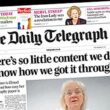The history of American magazines can be defined by the 96 years of Time Inc which was this year ignominiously swallowed by out-of-towner Meredith. In the UK, Time’s former subsidiary (long known as IPC) provided a similar backdrop. But, for many Brits, the most dramatic picture of magazine fortunes for the past 30 years has been provided by Future Plc.
It is exactly 20 years since founder Chris Anderson joined with private equity to buy-back the specialist consumer magazine publisher he had sold to Pearson just four years earlier. The price was almost three times what Anderson had pocketed from the 1994 sale, but the numbers were to get even wilder. Within 18 months, Future (swollen by startups and acquisitions across Europe and in the US) had taken the London stock-market by storm. An IPO valuation of £577m bounced to £1bn within a few weeks.
The publisher built its reputation on premium-priced computer games magazines including “official” publications on behalf of Sony, Microsoft and Nintendo. It capitalised on the boom in magazine retail sales and worldwide licensing.
For UK commentators and financial analysts alike, this was a very British business taking on the world from its headquarters in picture-book Bath. Anderson, had started the company after graduating from Oxford University and becoming passionate about 1980s computer games and technology. He launched his first magazine in 1985 from his kitchen table, with a £15k bank loan.
For the next seven years, the fledgling company doubled its turnover, profit and number of employees every single year. In pre-internet days, the magazines were “interactive” with cover-mounted CDs and computer games demo disks. Future described itself as “media with passion”.
In 1993, along came the mighty Pearson (then publisher of the Financial Times and Penguin books) to buy the company for £52.5m. Anderson banked the cheque, flew west and set about creating a similar business in San Francisco. He took the US magazine market by storm – in the very years when the then much more successful UK magazines group EMAP (remember them?) had begun what became a nine-year death spiral after a disastrous $1.5bn US acquisition.
In 1998 – while EMAP was still celebrating its fateful entry into the US market – Pearson lost its passion for Future and sold it to APAX private equity, Chris Anderson, and long-time CEO Greg Ingham. The US and UK companies were brought together and IPOd in 1999, as media stocks limbered up for the first dotcom boom.
Analysts were euphoric about the media company which seemed to symbolise the technological promise of the new millennium and the whacky new world of the internet. They applauded the buzzing production line of tech magazines and even the ‘reinvested’ profits (i.e. losses). It was all about growth.
Future peaked at 101 tech-driven magazines in six countries selling 5m copies every month, with some 2,000 employees. Turnover hit £250m as the Playstation generation made Future and its founder rich – on paper. But it was all too good to be true. At the height of the boom, APAX (which had once touted an unlikely digital-analogue merger with IPC) escaped with its ramped-up winnings – and left Anderson to face the bust.
No sooner had the fog cleared on the ‘millennium bug’ than investors turned angrily on the dotcom “growth-is-more-important-than-profit” companies they had once eulogised. Future’s share price collapsed, along with magazine sales and investor confidence. Only debt was rising as its stock-market value crashed to a mere £25m.
The company was saved by a last-ditch share issue and (phew!) the sale of Business 2.0 magazine to Time Inc. That single magazine seemed to epitomise Future’s boom and bust. Business 2.0 was for the ‘new digital economy’, with a brand suggested by Amazon’s Jeff Bezos. It briefly became one of the fastest-growing magazines in the US, notching up 2,000 pages of advertising in its first year. In two years, copy sales doubled to 210,000 which propelled a 575% increase in advertising pages from March 1999 to March 2000, as the country’s most talked-about magazine moved up from monthly to fortnightly. It was rocket fuel for the IPO. But the Business 2.0 dream of editions all over the world came crashing down, although not before the eleventh-hour rescue. Time Inc’s $68m acquisition of the magazine (two years after its own disastrous 2000 ‘new economy’ merger with AOL) saved Future from bankruptcy.
Anderson completed the rescue of his company before making an emotional exit. He left Future armed with the fledgling Imagine Gamers Network and the little-known TED conference which his Board colleagues were relieved to offload for 40% of what they had so recently paid for it. He was left to rue the day he had befriended private equity and the voracious stock market.
Time Inc itself was a reminder that Future was not the only media company to have had its head turned by the clamour of tech-mad investors in the early days of the web. But Future’s dependence on the sugar-rush of high-price news-stand sales (rather than on the recurring revenue of subscriptions) reflected under-investment, which became clear as digital media ripped through the economics of print in the following decade.
But things change quickly at Future and, the year after being saved by the sale of Business 2.0, the company was powering forward again with profits of £18.5m. Then, four years later, CEO Greg Ingham became the casualty as 2005 profits fell by 47% to £12.5m.
He was succeeded by Stevie Spring whose optimistic five-year spell as CEO also ended abruptly, in 2011, when profits crashed by 55% to £3.7m. Former TV news executive Mark Wood became CEO for three years until – another profits crash. On-script, the next CEO was the company’s Chief Financial Officer Zillah Byng-Thorne. The background of the fourth CEO in nine years seemed like a gift to investors worried about the company’s financials.
Now, five years later, that’s exactly how it looks.
A ‘new’ Future
In 2017, Future increased revenue by 43% to £84m, with EBITDA profit doubled to £11m and three times that of 2015. The results highlighted digital revenue including £9m from e-commerce. Another striking feature was the growth of print magazine revenues which increased by 43%, principally through the 2016 acquisition of tech publisher Imagine. It had been able to squeeze profit growth from micro-managing print even while pushing on with its headlining digital strategy.
In 2018, Future has reported that total revenue for the six months to 31 March increased 25% to £51.1m (2017: £40.9m, 2016: £30.2m) as it pushed hard into the e-commerce and events which now generate 51% of Future revenues. It is expected to achieve EBITDA of £16.7m for the whole of 2018 – a winning 18% profit margin. The US has returned to solid profits with more than 60% of its 2017 revenue from e-commerce. The UK public company whose international forays and a UK split between offices in London and Bath had inflated infrastructure costs, has now brought overheads below 22% of revenues, compared with 27% four years ago.
Future (again) owns some 100 brands, mostly in the UK, US and Australia, including T3, Total Film, PC Gamer, Digital Camera, Guitarist, and Computer Music. It still publishes more than 85 print magazines and 480 annual bookazines. But it also operates some 50 annual events and its largest brand is the digital-only TechRadar gadget site which may have revenue of some £20m. The company claims “daily to connect over 120m people with their passions through content, events and proprietary technology”. The declared strategy is to become a global content provider with a spread of revenues from advertising, e-commerce, events, licensing and readership.
The medium-term aim, presumably, is to generate the majority of its revenue from e-commerce, the holy grail of publishers everywhere since the digital titans stole most of the advertising. Generating commission from ‘click through’ product sales to readers can be more secure revenue than mere display advertising – and in times when online readers will be ever more reluctant to pay for all but the most exclusive content. In 2018, therefore, the only question is whether Future’s current growth trajectory is the real deal after a history punctuated by short-run success.
Arguably, the company’s clear need for transformational change in former times kept getting hijacked by what proved to be short-term profit spikes and trademark confident recovery. The whole bloody history was due, arguably, to a cocktail of weak systems, global over-reach, some flawed M&A, and high overheads. Even before the web disrupted media everywhere, the sparky specialist magazine business was never quite up to the ambitions wished on it by fickle investors.
Perhaps, this time, it is different.
Brits will understand just how reassuring Future’s institutional investors find the Scottish cadences of Zillah Byng-Thorne. The Scots founders of modern retail banking have left their prudent mark on the UK psyche, and the Future CEO fills investor presentations with calm commitment to continual change, reinvention and the restless search for new markets and opportunities. Even her big claims sound under-stated.
The company now operates in six main verticals, four of which (technology, games/entertainment, photography/design, and music) each have global audiences of about 30m. That online reach emphasises how the web has transformed the potential for what once were small specialist magazine markets. The company whose CEO is not getting carried away by results that are starting (again) to get investors excited, has always had technology smarts: its 20m-audience TechRadar is 10 years old. But there are at least three ways in which this battle-scarred, magazine-centric company can claim to be brand new:
1. Technology: Future is becoming a tech company. Not because it doesn’t still own hundreds of print publications which employ the largest slice of its 700 people. But because of the proprietary technology that enables it to create, use, adapt, re-use and analyse its content internationally and in many languages. It has invested in systems that are scaleable and relatively low-cost. It has the technology it needs and owns it. While the capabilities of its Hawk e-commerce software, developed in 2014, do not sound too special, Future’s emphasis on a stack of bespoke systems that can be speedily rolled-out to new businesses without much difficulty or cost is highly strategic. While its e-commerce revenue is really only just beginning, Future last year generated 165k sales a month with a retail value of almost £150m, through affiliate marketing revenue (earning sales commission primarily from Amazon, without the risk of unsold inventory). It claims relationships with 7,285 retailers and a database of over 250m products.
Fully one-third of Future’s readers are described as wanting to buy something, and the content is increasingly built round the reviews, buyers’ guides and ‘top 10’ content which attract searching online audiences and can propel e-commerce and programmatic advertising revenue. The 2017 acquisition of Centaur Media’s Homebuilding magazines and exhibitions creates the fresh opportunity for a further step-up in e-commerce (initially in the UK but, perhaps, also in the US). The expected digital plans for the interface between exhibitions, content and e-commerce may also give some pointers to what disruption can mean for traditional trade shows. The content (and history) of Future might all start from print but the digital potential is unmistakeable.
2. Management: The inability of incumbents in any market to respond adequately to digital disruption is often in the hearts and minds of long-standing executives. New-style companies need new skills, experience and the ability to see things differently and to challenge legacy business. Future’s 10-person senior executive team has a blend of skills and only two come from magazine-media. Further, only one of the 10 has been with Future for longer than five years: most were recruited during 2016-18. There is a healthy spattering of talent (including the CEO and CFO) with deep experience at AutoTrader, still the best UK example of print media becoming a pure-play digital success. Byng-Thorne dares not dream of achieving anything like AutoTrader but she is building a team for the task.
3. Acquisitions: Future has made no fewer than eight acquisitions in the past three years. These investments have helped extend the company’s reach into e-commerce, exhibitions, the US and Australia, as well as firming up the profits (and content) from print. It has used a buoyant share price and low interest rates to make good gains, despite sometimes paying full prices for its deals.
In 2016, Future paid a total of £15.9m in shares and cash for Imagine’s 19 magazines and hundreds of bookazines – a price of about 1 x revenue. It is easy to see that the bookazine format (premium-priced magazine-style reference books) is becoming an increasing focus of Future’s print operations at the expense of monthly magazines. Give or take inevitable fears about the fragility of news-stand retailing, it’s a good strategy to help prolong the profitable life of printed content. Imagine was the first of five major acquisitions by Future in the past three years including: Homebuilding (£32m); four magazines from Haymarket (£13m); Newbay, US B2B media (£9m); and the recently-announced US tech publisher Purch (£101m). That’s the biggest test yet and not just because it’s the highest price.
Purch, whose brands include Tom’s Guide, Tom’s Hardware, Top Ten Reviews, and Live Science, made EBITDA profit of $10.1m on $46m revenue in 2017. It is described as “a leading US digital media publisher with owned and operated sites and strategic partnerships, acting as an advertising technology network.” What that means, among other things, is that the company (formerly known as “TechMedia Network”) generates some 28% of its revenue from selling digital advertising on behalf of other publishers, described in the accounts as “publishing services”.
This extended network can provide real programmatic advertising and e-commerce power for the Purch-Future combination but it’s sensitive for two reasons. First, the much-trumpeted Purch technology news network includes owned media brands and a tail of at least 10 third party clients. Second, the gross margin of these third-party revenues is only 22%, compared with 91% from its owned business (so that slice of revenue may yield very little direct profit). The Purch network currently accounts for some 52m monthly uniques but almost one-third of this belongs to a single digital media company, Mobile Nations. It is reasonable to think that Mobile Nations (founded by high-rated ex CNet executives) may itself eventually be sold – and, therefore, withdrawn from the Purch network. Or perhaps Future will buy it. Meanwhile, though, the Purch deal pushes Future right up there with the US technology news leaders CNet and Ziff Davis, which means (hopes of) much more revenue than the sum total of Purch and Future.
But the Mobile Nations role, in particular, underlines the stretchy economics of the Purch acquisition and the need, therefore, for Future to capitalise quickly, for example, on the obvious opportunity for TechRadar to develop revenue to match the 32% of its audience that’s in the US. That, and the fact that a majority of Future’s total digital audience (but a minority of revenue) is in the US, creates the potential for real gains in revenue and profit. But it also puts the company’s acquisition strategy under the microscope.
Those five largest deals during 2016-18 had an aggregate price of some £170m and an average EBITDA multiple of x8, a good price for exhibitions and digital but not for print. The multiples paid for the individual deals ranged between x3 (Newbay) and 10x for Purch and also for Homebuilding (with revenues split 50:50 between exhibitions and print). With the Haymarket magazines at x6 and Imagine x5, these are not low prices for print-centric companies. The priciest other recent magazine-media deals in the UK have included: Dennis Publishing which fetched an estimated 6-7 x for a much above-average portfolio, including the subscription-based The Week and the fast-growing Buy-a-Car e-commerce; and the £200m-revenue Time Inc UK, reportedly sold for 6x EBITDA. Last year, Burda paid an estimated 7x EBITDA for Immediate Media, the UK’s most profitable magazines group.
Future’s deals underline the pressure to integrate and leverage its acquired businesses. Larger than expected revenue gains and cost savings can silence the doubts. But investor nervousness over the Purch acquisition was evident from a share price fall when it was announced. Such jitters often accompany gutsy UK investments in the US. But Future has had a transatlantic presence for 20 years and, even before this acquisition, employed more than 200 people there. However, one analyst has already said the deal “could make or break Future if they have bitten off more than they can chew.” But the “new”company’s track record of rebuilding in the teeth of digital disruption does instil some confidence that the ambitious US build-up will pay-off and that Future will be making total EBITDA profit of some £35m in 2019 – almost seven-times that in 2016.
Changing the balance
Zillah Byng-Thorne is demonstrating that effective media transformation can depend on buying large enough building blocks to change the operational balance of a legacy business. Future’s chunky deal-making has helped it acquire and fund new skills, technologies and services without the risk of suffocation by the old guard.
For all its bruising history, Future’s catalogue of vibrant magazine brands has reinforced the durability of special interest niches at a time when so much media has lost its business model or its audience. Even the war-torn years of ‘going global on the cheap’ did not kill most of the long-established magazine brands which now underpin the Future strategy for wholly-owned content that is expert, platform-agnostic, evergreen, and global.
Compelling content
The company is adapting to a world where traditional media must recognise the primacy of targeted, tailored content over bundled packages or the narrow confines of a single product or channel. Those seeking to build e-commerce must recognise that content becomes the means to generate revenue rather than an ‘end’ in itself. That dictates the multiple use of well-produced content. Curated lists and reviews can be as powerful in specialist media as, say, exclusive journalism in a daily news brand.
Byng-Thorne, the former Nestle graduate trainee and CFO of AutoTrader, is not the first Future CEO to recognise the enduring strength of specialist consumer media. But she has built the team and done the deals that have shifted the centre of gravity from print towards e-commerce, digital advertising and events.
The Future transformation remains a high-wire performance. Even the current market value of £200m (one-third of its IPO price back in 1999) shows how much this small public company still has to do. That is only part of the vulnerability. Fears about some of the deals are not confined to price. The company’s Newbay diversification into B2B (albeit in related tech, music and entertainment sectors) flies in the face of media orthodoxy. While some ‘twinning’ of B2B and B2C media can be synergistic, the dynamics are often quite different. The acquisition from Haymarket of soccer-football brand FourFourTwo and the outdoor leisure magazines Practical Caravan and Practical Motorhome – alongside the tech-focused What HiFi – is similarly open to question. Football might fit well with Future’s young audience (even if the media competition in the world’s largest sport is especially challenging). But caravans and motorhomes (many of whose readers are aged 55+) seem like a joke alongside Future’s youth brands.
It is assumed that Haymarket had bundled the two ‘outdoor leisure’ magazines to FourFourTwo, What Wifi? and Stuff, the gadget mag which competes with Future’s T3 and must have been a prized ‘consolidation’ target. In the event, UK competition authorities blocked the Stuff purchase but Future bought the rest. Such mixed-bag deals will be forgotten if the company is able to keep cranking out the profit growth, especially in e-commerce. Indeed, the portfolio diversity might even help sustain the growth when things get bumpy. But, inevitably, any acceleration in the decline of print copy sales and advertising could be especially painful.
There may also be concern about how any economic slowdown might stifle Future’s e-commerce growth and, for example, impact the commission levels paid by the likes of Amazon. The geographical spread (now with more than 50% of profits due to come from the US) is some protection. Perhaps, the not-so-volatile caravan market might even help.
So there are clear risks. But the company is in confident mood, committed to its strategy of creating global platforms for specialist media communities with diverse revenue streams. It has, notably, notched up more than 50% growth in media revenue per online user over the past two years.
Future Plc is a work in progress but it is becoming a case study for traditional media everywhere: building a new tech-driven global media company with a fresh business model from the special interest communities that were once just magazines. Former owner Chris Anderson’s US-based life’s work is now the brilliant TedTalk global ideas network. But, back home in Bath, the excitement has returned. So far, so good.




